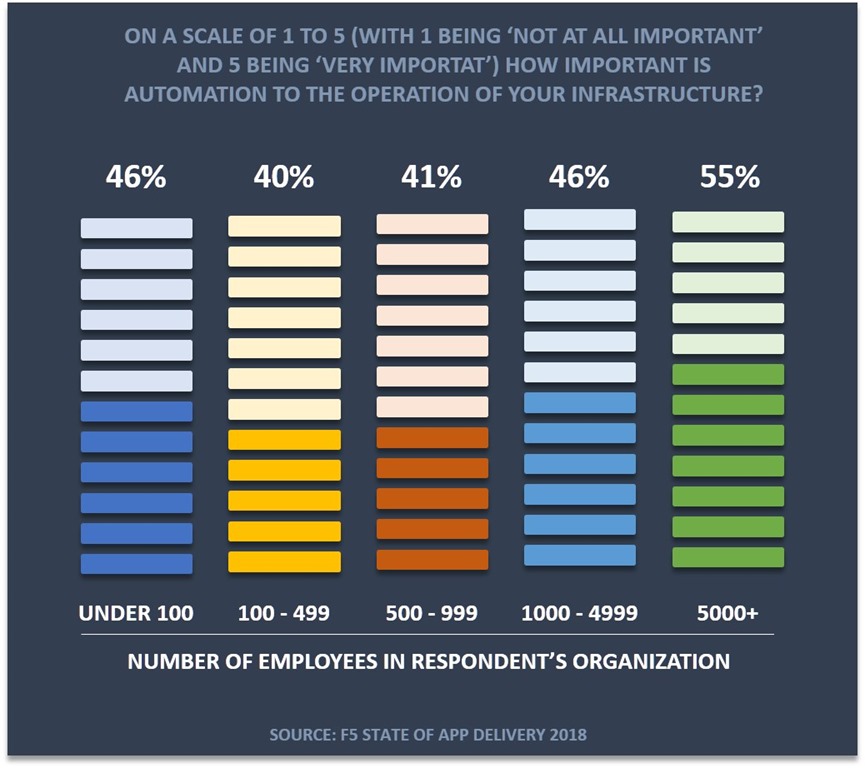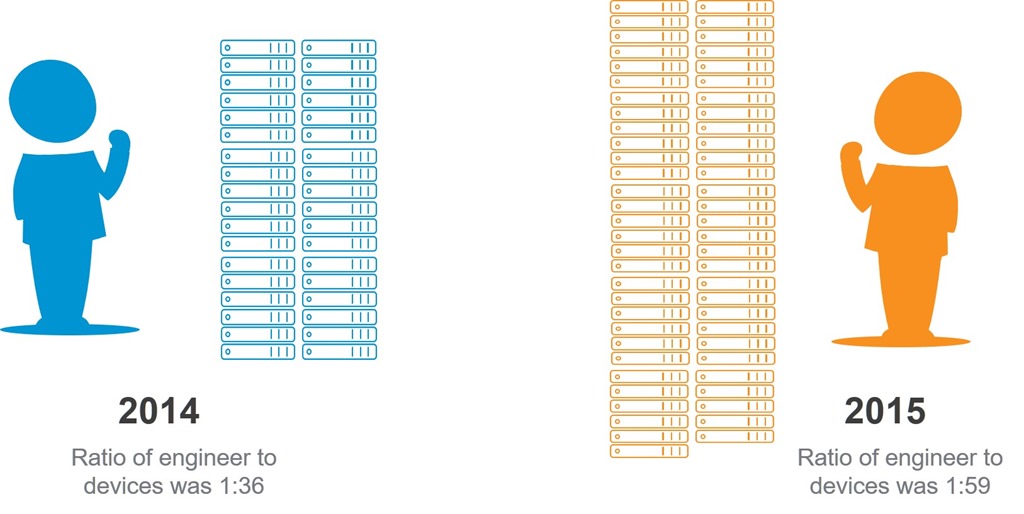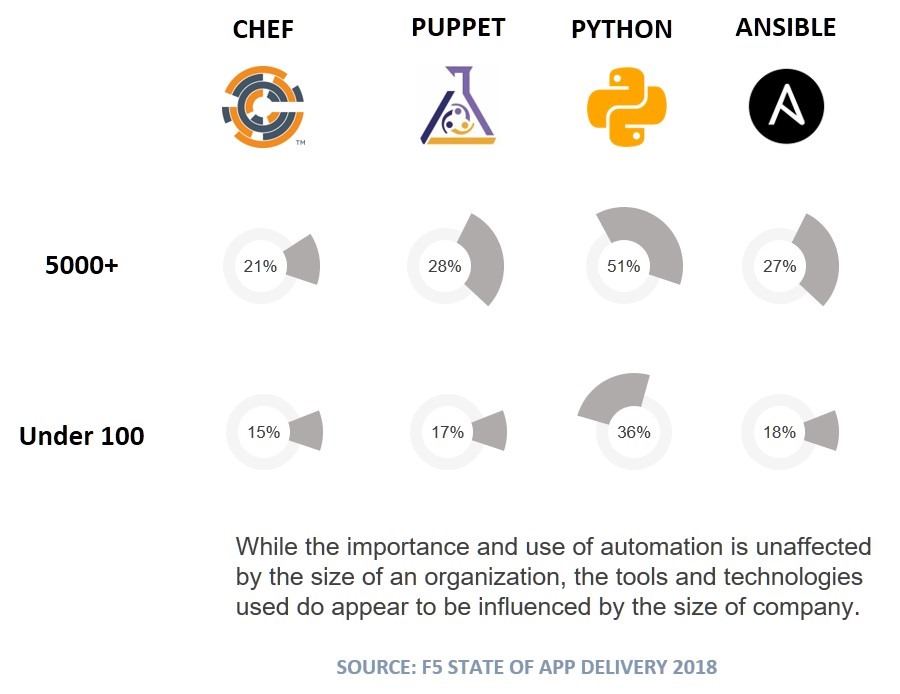Size Matters (But not that Much) in Network Automation
So says the data.
It would be easy to dismiss the importance of network automation by claiming that the size of your organization (and subsequently, demand) doesn’t warrant the admittedly significant effort required.
After all, if there’s only a hundred folks in your organization, there just can’t be that much demand. Can there?
Yes. Yes there can.

Cloud and its partner DevOps have disrupted a lot of things, but one we rarely discuss are the old “size of organization” buckets we use to classify businesses. You know, SMB. SME. Large Enterprise.
The traditional target markets have long been based on size of its employee base. While countries have legal definitions (for governance and legal application) they are not as relevant for purposes of software vendor segmentation, which dictates whether or not they clamor for your attention – and dollars. The premise being that the more people, the more are required to service the corporate population. The more technology, the more complexity. The more complexity, well, more everything.
In the software vendor world, the size of your data center and complexity of processes are highly relevant. Both are usually tied to the size of your organization (number of employees) because it’s expedient.
But cloud and DevOps are doing to the size of organizations what virtualization did to the density of “servers” in the data center. Remember the virtual explosion? We went from a server-per-application model to a virtual server-per-application world, in which a single physical server hosted ten or twenty virtual servers. The “data center” grew from one hundred servers to one thousand and more, with an explosion of applications. And yet the actual physical size of the data center didn’t change. And in many cases, neither did the number of operators.

To wit, Computer Economics – which tracks all manner of staffing levels – found a significant increase of the engineer to device ratio over just one year. In 2014, one engineer was responsible for 36 devices. A year later? That same engineer was expected to manage 59 devices.
In the realm of application infrastructure, similar increases were taking place. It was made possible, in part, by virtualization and some helpful automation on a limited scale.
What we did was increase the efficiency of both the physical server and its physical operator.
Fast forward to today. Cloud and DevOps and the newest member of the gang, NetOps, are going to (and have already begun to) do the same thing to the size of IT as we did to servers with virtualization. Using automation along with cloud (and containers) we are dramatically increasing the efficiency of operations. Which means we can support ten or twenty times the applications and operations we do today without significantly changing headcount.
We can operate a “large enterprise” on a “small enterprise” budget*.
It’s nearly impossible to blindly look at employee count and gauge whether or not a product or solution is relevant. Because that thirty-person organization (SMB by just about every definition – market and legal) might be hiding a few thousand instances of an application in the cloud or in its own data center.
Because automation – whether thanks to public cloud or DevOps – really does increase the efficiency of operations by an order of magnitude.
Size (Mostly) Doesn’t Matter to Network Automation
Which is why it’s unsurprising to see that when it comes to network automation, there is little differentiation between the views, drivers, and adoption across the size of organizations. We found that 9% of organizations with under 100 employees were fully using automation in production. On the other end of the spectrum, 8% of organizations with over 5000 employees told us the same thing. In the use of automation to deploy major changes into production, 23% of those organizations under 100 employees always use automation. For organizations with over 5000 employees, that number rose only marginally to 25%. Firms in the middle showed little deviation – ranging from 21% to 23%.

Where we found differences based on size was in the tools and technologies used for network and operational automation. Most striking, perhaps, was the significant spread between small and large organizations in the use of Python scripts. The majority of large firms (over 5000 employees) appear to have embraced the technology, likely thanks to the availability of talent and the greater need for bespoke automation based on the variety of operational processes in place.
Conversely, just over a third (36%) of very small (under 100 employees) organizations are using Python scripts. These organizations were also far more likely to be using “none” at 33% than their very large counterparts (20%).
In the network automation realm, this difference remained. Cisco, in use by 63% of very large organizations, was only in use by 35% of very small organizations. OpenStack brought the two closer together, with 29% of very small firms and 36% of very large orgs, as did VMware. The virtualization giant is used by 63% of very small organizations and 73% of the very large.
The spread between organizations uses “none” for network automation was surprisingly smaller than those eschewing automation toolsets. Only 8% of very small orgs are not using anything for network automation along with a mere 5% of very large enterprises.
The reason this is all so interesting is that ultimately, automation requires some kind of software – whether bespoke (custom Python scripts) or frameworks (Chef, Puppet) or more engine-based (Ansible, Cisco, OpenStack, VMware). The historical practice by software providers of segmenting organizations based on the size of their employees doesn’t make much sense in the face of rising operational efficiency due to the adoption of automation.
One of the biggest drivers of automation in the network (and across IT) is operational scale. That means more technology not more employees. That’s actually what we want, after all. We’re trying to avoid running afoul of Brook’s Law by leveraging technology to relieve the need to pile on people and make more efficient our day to day operations.
It may be time, then, to revisit our superficial designation of organizations relevance to technologies based on their size. Because as Mark Twain famously said (or didn’t say, as the case may be): It’s not the size of the dog in the fight, it’s the size of the fight in the dog.
That little dog, powered by automation, has a whole lot more fight in him than meets the eye.
